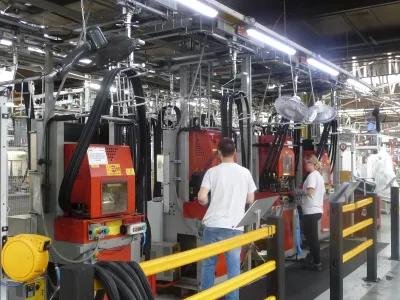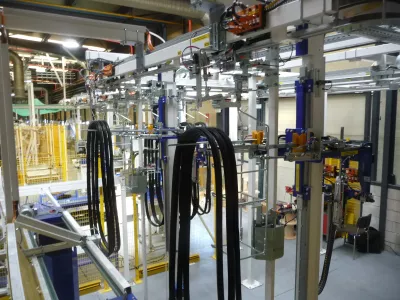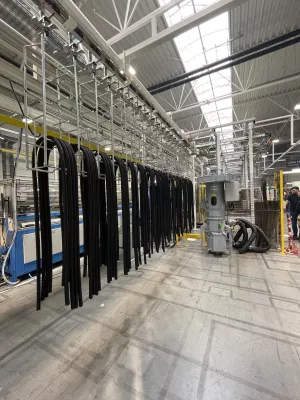CONVEYORS
for seals
CONVEYORS
in the industry
In the industrial sector, every detail counts to guarantee the efficiency and quality of production operations. Handling and transporting loads can hamper the smooth running of manufacturing processes. To optimize workflows, manufacturers frequently install overhead conveyors. These overhead handling systems offer an efficient and safe solution for transporting fragile materials. This is particularly the case for seal manufacturers. The advantages and applications of overhead conveyors for this type of product are numerous. Find out why it can be a valuable option in this kind of industry.
WHAT IS AN
overhead conveyor for seals?
An overhead conveyor for gaskets is an automated transport system specifically designed to handle and move lightweight components, such as rubber profiles or gaskets, within a production area. This conveyor combines suspended rails and carts to move parts along production lines. This overhead handling system is a smooth, efficient solution for transporting and handling delicate materials. That’s why it’s common to find this system in the automotive industry. It can be used to convey seals to workstations.

Sealing station fed by a Technimanut bi-rail overhead conveyor
WHAT ARE THE ADVANTAGES
of overhead seal conveyors?
The overhead conveyor for joints is a handling system that offers many advantages to manufacturers:
1. Reliability: The overhead conveyor is generally automated to guarantee a precise rate for the parts to be handled. It ensures that production runs according to set targets.
2. Reduced risk of damage: By suspending joints above the ground, overhead conveyors reduce the risk of damage caused by vibrations or shocks that can occur with traditional conveyors. They therefore guarantee product quality.
3. Space optimization: by using overhead space, this bi-rail handling system optimizes floor space in production areas. The joint overhead conveyor frees up floor space for other equipment or to facilitate the movement of production operators.
4. Adaptability: Overhead conveyors are generally custom-designed. It can therefore be adapted to different types of joints. It can be set up according to the configuration of the production area. Modular at will, it offers a flexible solution for the changing needs of all industries.
5. Fast ROI and profitability: By automating the transport of gaskets, the overhead conveyor reduces downtime and increases production speed. This in turn boosts industrial productivity.
6. Prevention of MSD (Musculoskeletal Disorders): by automatically transporting joints to the operators’ workstations, the overhead conveyor saves production operators from repetitive movements or even untimely displacements. The conveyor makes workstations more ergonomic.
WHAT ARE THE DRAWBACKS
of overhead handling solutions for seals?
1. Initial cost: Installing a seal conveyor can represent a significant initial investment, especially for highly automated or customized systems.
2. Maintenance requirements: Like all industrial equipment, conveyors require regular maintenance to keep them running smoothly. It may therefore entail some additional costs and require technical expertise. Consider taking out a maintenance contract, or regularly checking your installation in-house.
3. Space requirements: Although the joint conveyor optimizes the use of floor space, it still requires vertical space. This can be a constraint for installations where ceiling height is limited.
4. Electrical dependence: Joint conveyors are generally motorized. It depends on a power supply to operate, which can lead to production stoppages in the event of power failures.
FIELDS OF APPLICATION
of the overhead conveyor for seals?
Overhead conveyors for seal handling are used in many sectors:
– Automotive industry: used to transport seals, body parts and other lightweight components on automotive assembly lines.
– Aerospace industry: suitable for transporting seals and critical components in aircraft manufacturing (airplanes, helicopters, etc.), where precision and safety are paramount.
– Electronics industry: used to transport sensitive electronic components on electronics production lines.
– Medical industry: used for precision handling of seals and parts in the design of medical equipment and biomedical devices.

Overhead conveyor for automotive seals
CRITERIA FOR CHOOSING
a seal conveyor
To choose the best seal handling system for your industry, make sure you define :
1. Type of joints: analyze the type of joints or parts you’re handling: their size, weight and fragility. Some conveyors are better suited to certain types of material than others.
2. Load capacity: evaluate the conveyor’s load capacity to ensure that it can efficiently transport joints or parts without compromising safety or transport quality.
3. Production line configuration: consider the layout and configuration of your production line. This will enable you to determine the conveyor type (overhead or traditional) and configuration options that best suit your space and production needs.
4. Production rate: determine the speed at which joints will move along the production line. The conveyor must meet your speed requirements while maintaining a certain level of precision and safety.
5. Flexibility and adaptability: look for a conveyor that offers flexible configuration options. Consider that it must be easily scalable to meet future changes, either in your production processes, or in the types of products you handle.
6. Level of automation: evaluate the degree of automation required for your production process. It may make sense for your conveyor to be programmable, to incorporate detection systems and synchronization capabilities with other equipment.
7. Reliability and maintenance: make sure you choose a quality conveyor, manufactured by a reputable supplier. If you can’t do your own maintenance, consider negotiating a maintenance contract when you buy your system.
8. Calculate your ROI (return on investment): evaluate the total cost of your investment. Include installation, training and maintenance costs. Depending on your estimated production targets, you’ll be able to calculate its amortization.
SEALING CONVEYORS
and accumulation
An accumulation conveyor has an ingenious mechanism for temporarily storing parts when there is a stoppage or slowdown in the production process. When production resumes, a continuous flow is maintained. This type of process is often used in the automotive industry, for example, to transport seals. When the production line is active, the seal accumulation conveyor operates at the same speed as the other equipment on the line. Products then move normally along the conveyor. This type of conveying ensures efficient production, particularly on assembly lines.

Overhead conveyor accumulating seals on production line
As you can see, an overhead seal conveyor offers an efficient, reliable solution for transporting delicate materials in a variety of industrial sectors. By improving precision, safety and productivity, these systems can play a crucial role in optimizing manufacturing operations. By investing in an overhead conveyor tailored to your specific needs, you can transform your production process and gain a competitive edge in the marketplace.